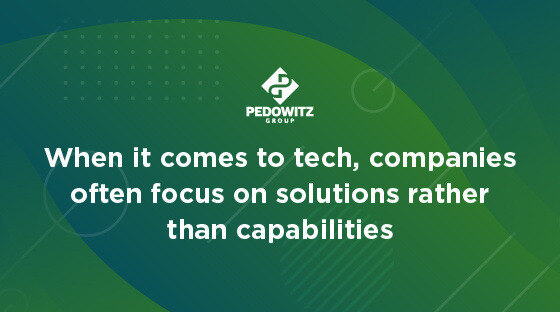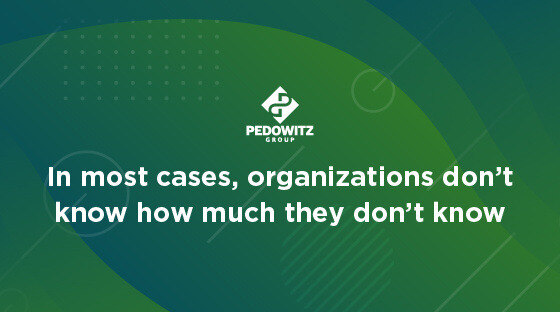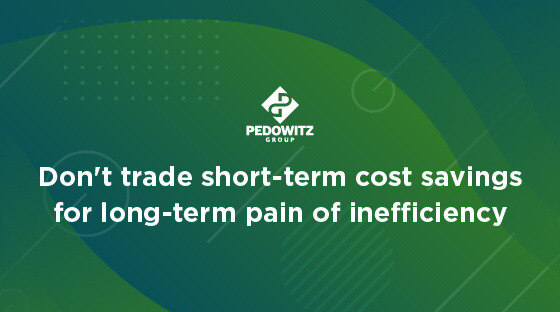Stop me if you’ve heard this from your senior leadership before:
“Listen, we have all of these marketing tech platforms and tools we’re paying for. Honestly, we’re probably spending a whole bunch of money that we shouldn't be spending. We've got stuff everywhere. I don't even know who uses this, or who owns that.
Let’s do a comprehensive inventory exercise and see if we’re actually using this stuff. If not, just get rid of it!”
At The Pedowitz Group, we’re not immune to this either. Due diligence is always done around budgeting time, and we don’t want to waste precious budget allotments any more than your organization’s marketing leaders do. The fact is, CMOs are still spending a full quarter of their budgets just on technology.
I realized some time ago, however, that there’s sometimes a fallacy in that line of thinking: Products that might seem redundant or unnecessary are often just underutilized.
That means your tech stack – the same one that you’re agonizing over and under orders to trim by any means necessary – probably has some hidden value that you just haven’t realized.
We should probably talk about that.
The Redundancy Fallacy

A perfect example of this involves a client we worked with not too long ago. They wanted us to help them audit their tech stack to see what was “needed” and “not needed”.
In this case, the client was using two different survey platform tools. The conventional thinking was “Why have both? One is used for external NPS (net promoter score) surveys and the other for more internal and anonymous surveys. Surely, we wouldn’t want to mix and match the data, right?”
Well…..not exactly. Upon further examination, we realized that a lot of their data confusion was because the implementation of one survey tool wasn’t integrated with their existing MAP systems. They also didn’t have a clear vision for what they wanted to do with surveys in the first place.
In short, they were focused on solutions rather than capabilities, and this is an area that a lot of companies struggle with.
Don’t sleep on features
Another client had two similar social media platforms, but both were being used in very different capacities.
- One provided robust customer data via “social listening”.
- The other was a comprehensive posting tool with good “per post” metrics.
The client wanted to scrap one of the platforms to save roughly $10,000 in annual license fees.
That’s the immediate obvious benefit, but upon further examination, we helped determine they could yield an additional $50,000-$100,000 in revenue if both tools were implemented correctly and worked with each other efficiently.
Just like many cars are now sold with stickers that identify total cost of ownership (which factors in gas, maintenance, etc.), companies looking to audit their tech stack must look beyond the upfront price of a platform when determining value.
Even more importantly, clients purchase tech and they don’t necessarily keep up with the features or other add-ons that a vendor includes in the platform or service. Salesforce is a great example of this as they are constantly releasing new features and functionality. Understanding that a feature exists and then developing the strategy to best utilize that feature can give a customer an immediate boost in the ROI of that platform or service.
Data Collection and Integration
The inability of a platform to deliver maximum results may be a product of how it was implemented and integrated into existing technology. Improving data quality and availability may drastically increase the functionality and better leverage the features already available in a platform. Data quality and availability drastically impact most tools that have a workflow or reporting feature.
It may be a drastic example, but imagine having a robust MAP with orchestration capabilities that is not integrated at all with your CRM.
How will it know what is going on to make the most accurate decisions on how to engage with customers?
Everyone gets this for the MAP and CRM situation but I have often seen clients that have only a small subset of data in their data warehouse and then very limited fields exposed to their BI (business intelligence) or data visualization platform. That is certainly not setting up your data tools for success.

We see this often when it comes to organizational structure getting in the way of getting the most out of tools. Different teams have different visions for the tool. In a typical use case, the sales team wants to be able to sell, quote and track better – all while building more opportunities. The marketing team is focused on leads, engagement, and attribution of their efforts against revenue.
Once you look at the organization as a whole, however, the cracks in integration begin to show. Now, we see emails siloed in Salesforce or Marketo that only one team has visibility into. Why don’t customer success teams have integration with both sales and marketing? Why aren’t emails, NPS surveys, etc. properly being triggered with the appropriate action across these teams?
The answer in most cases is that these organizations don’t know how much they don’t know. A lot of platform “fails” are simply failures to understand how best to utilize and integrate the tech in an efficient and cross-functional way.
Instead, many organizations are a loose collection of individual business units operating as separate entities within that particular enterprise. This leads to the enterprise questioning why they’re spending so much on so many different platforms, leading to a culling and forced adoption of a single solution that isn’t ideal for the disparate needs of sales, marketing, and customer success.
That means just one thing: trading short-term cost savings for long-term pain of inefficiency, support resources, and operational friction – all of which usually cost more than an annual platform license fee.
It takes a village

Technology rarely runs itself and requires no maintenance. The responsibility to evaluate and maintain platforms is critical for ensuring they continue to deliver value. Simply making it someone’s job to “own and manage” a platform and ensuring they are properly trained may make a huge difference in how well that platform can satisfy critical business needs.
These are only a few very specific examples but a more complete audit of a platform or the entire architecture uncovers various other scenarios that inhibit the functionality of platforms and the value perceived from having that technology as part of their stack.
We have an entire evaluation method for understanding what technology aligns with the business goals and capabilities to support those goals to find the opportunities for improving the usage of existing technology and for making the best selection of new platforms or services to augment the stack.



